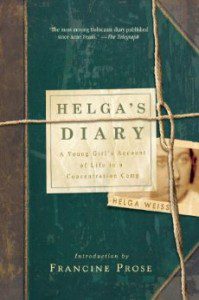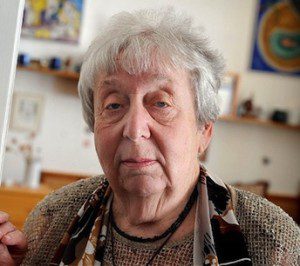
In the early hours of March 15 1939, the German army crossed the Czechoslovak border and made their way toward Prague. For Helga Weiss, an eleven-year-old Jewish schoolgirl who lived with her parents in the capital, it was too much to take in. And yet while she was unable to grasp the significance and predict the consequences, she could at least gauge the mood: “There was something heavy in the air,” she wrote in her diary that day, noting her parents’ despondency at home and the normal chatter and laughter at school reduced to furtive conversations and frightened whispers. Czechoslovakia was swiftly incorporated into the Third Reich and renamed the Protectorate of Bohemia and Moravia. Just as quickly came the Jewish restrictions—”orders one after another that repress and wound us more and more,” Weiss wrote.
And she wrote, now as often as she could, documenting each new wave of Nazi persecution and aggression. The family was eventually transported to Terezín and then inevitably deported to Auschwitz. Miraculously, Weiss survived; her account of her ordeal did too, and the manuscript, scribbled on school exercise books, has now been translated and published as Helga’s Diary. Most of the diary was written in real time, as it were, as events unfolded, but Weiss knew that anything she brought with her to Auschwitz would have been confiscated on arrival, and so the later entries take the form of recalled experiences that were added retrospectively after the war and her return to Prague. The diary’s survival story is as incredible as that of its author. When in Terezín she learned she was to be in the next transport to the east, she entrusted her diary to her uncle in the records department who bricked it into a wall in the barracks. In 1945 she reclaimed it, returned to work on it, and began the arduous process of rebuilding her life.
Helga’s Diary is divided into three chronological sections: “Prague,” “Terezín,” then “Auschwitz, Freiberg, Mauthausen, Home.” The first section takes us through those Nazi decrees, a steady escalation of curtailed freedoms (no swimming, circumscribed shopping and travel, the yellow Jude stars) which culminates in enforced terror (deportation to the camps). “Everything is our fault,” Weiss writes, “even though we didn’t do anything.” Her friend Eva stops speaking to her. She is slowly but systematically separated from Jewish friends who disappear on trains. Each stricture and loss is related coolly and accepted stoically, without any hint of self-pity. She tries to wear her yellow star with pride, to demonstrate to the Germans on the streets that she isn’t bowed and beaten.
This is our first taste of Weiss’s courage and resolve. At times her optimism, fortitude, and rational sense of perspective belie her age. “I have to bear up,” she scolds herself, “there are other things waiting for me and many of them will undoubtedly be much worse.” Things do get worse. She is sent to Terezín shortly before her twelfth birthday and is incarcerated there for three years. Despite being wrenched from her father and both witness of and victim to immense cruelty and deprivation, she manages to remain physically and psychologically undefeated—even able to bolster her mother’s flagging morale. There are fascinating descriptions of the rich cultural life that flourished and endured behind bars, and of the Nazi’s clean-up job to dupe visiting Red Cross inspectors into believing that the prison ghetto was in fact a “spa town.”

But transit camp gives way to concentration camp and those faint flickers of hope that sporadically light the Terezín extracts are snuffed out on arrival at Auschwitz. Terezín, Weiss decides, was “an absolute paradise” in comparison. After a while, rumors about gas chambers and the constant stream of black smoke pumping from chimneys coagulate into unpalatable truths. But Weiss and her mother are moved on to Freiberg, where they join a slave-labor unit polishing Luftwaffe planes and riveting their wings, all under the gaze of a particularly sadistic Aufseher and the threat of destruction from nightly air raids. Finally, both wind up in Mauthausen, Austria, yet another camp, where Weiss discovers that thirst is worse than hunger and lice are more deadly than freezing temperatures, and wonders if she can fend of all four before liberation, at once tantalizingly close and frustratingly far off.
Helga’s Diary is narrated in simple, lucid language. Weiss seems to doubt her talent, for in her introductory note she apologizes: “The writing is childish, the style prolix, naïve.” In some respects, she is right, but that naïveté is also one of the book’s strengths and helps endear us to its author all the more. And while the writing may be childish, Weiss’s actions and behavior are quite the contrary. She was forcibly thrust into adulthood and compelled to make adult decisions—the most important being when she arrives at Auschwitz, joins the line for the selection process, and at the last minute, lies about her age to Dr. Mengele, securing, in a sense, a permit to work and not a warrant for death.
In addition, there are occasional flashes of dark humor. At one point in Terezín, “Jaundice and typhus are out of fashion. A new illness has appeared—encephalitis.” When she tells us that Birkenau is a work camp, we the reader, armed with the full facts, wince as that childish naïveté engenders grim irony. Best of all, however, is page after page of writing that candidly, expertly, showcases humanity at its best and its worst. Toward the end, Weiss observes prisoners who “were once people,” with “Love for life, for good things, for beauty, with faith in a better tomorrow. What’s left are phantoms, bodies, skeletons without souls.”
Also worthy of mention are Weiss’s own illustrations, which are interspersed though the book. After smuggling her first picture to her father in the men’s barracks in Terezín, she was encouraged to produce more of the same. “Draw what you see!” he urged her. Fortunately for us, she did. The first pictures are richly detailed, but as horror and despair creep in, her art becomes correspondingly grayer, the figures within mere shadows. An equally illuminating interview from 2011 is also included, in which we not only learn what happened to Weiss after the war, but also hear how a trip to Israel helped develop her skill as an artist.
Naturally, comparisons will be made to the other famous young diarist of that time, Anne Frank. Both are diaries of “a young girl,” and both girls were born in 1929. But as Weiss was never in hiding, instead shunted from one camp to another, such comparisons can only stretch so far. Perhaps most significantly, Weiss lived to tell her tale. Of the 15,000 children brought to Terezín and transported to Auschwitz, she was one of only 100 survivors. Cynical readers may still speculate whether we need another Holocaust chronicle by another young writer, a journal which catalogs what the writer sees without attempting to answer those still-open questions which may be intrinsically and so permanently unanswerable: why it happened, why those SS top brass and commanders of the Einsatzgruppen so dutifully obeyed Himmler’s tall order to act “superhumanly inhuman.” But Weiss has recorded rather than analyzed, and that is enough. Primo Levi has revealed that it was imperative his own story of Auschwitz, If This Is a Man, be “precise, concise, and written in a language comprehensible to everybody.” This chimes with what Weiss says at the end of her interview at the close of the book: “Maybe because it’s narrated in that half-childish way, it’s accessible and expressive, and I think it will help people to understand those times.”
The entry in Anne Frank’s diary for June 20, 1942 reads: “Writing in a diary is a really strange experience for someone like me. Not only because I’ve never written anything before, but also because it seems to me that later on neither I nor anyone else will be interested in the musings of a thirteen-year-old schoolgirl.” She was wrong, of course, about her “musings,” and we are lucky to have them. The same can be said for those of Helga Weiss, musings which, when tallied up, become the sobering account but also the insightful small wonder that is Helga’s Diary. In the end, it doesn’t matter how much was observed with wide-eyed ingenuousness and how much with eyes that had already seen. All that matters is that Weiss did see, and did record, and that we now have it.




